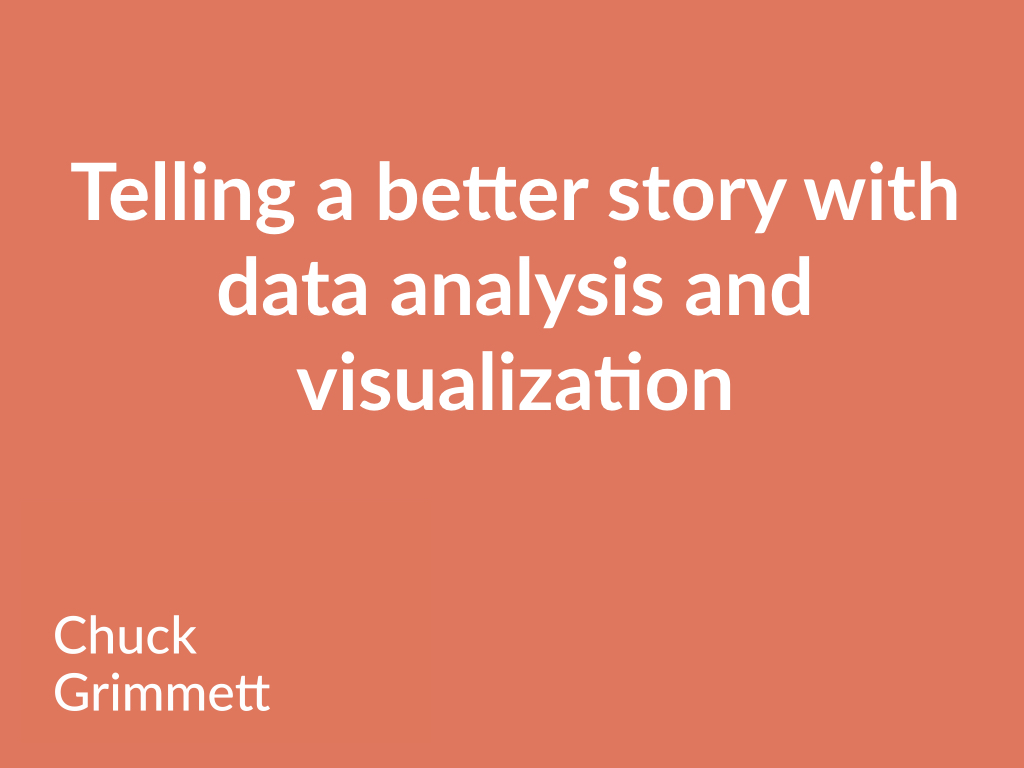On October 13 I ran a data-related workshop for the Praxis community.
I split the talk up into two parts:
- How you can apply the basic concepts of data analysis to your career, whether it be sales, marketing, shipping, coaching, cooking, management, etc. These techniques will help you tell a better story, be more convincing, and become more effective at your job.
- An introduction to visualizing data and information, including some tools, resources, and inspiration to get you started. If you are interested in data visualization, think of this as a jumping-off point.
The Slides

Download my slides without my talking notes ↓
Download my slides with my talking notes ↓
The Video
Thanks to TK Coleman for asking me to do the worksop and for recording the video!
The Links
Examples mentioned
- Word Cloud - Multiple ways of representation: Bar chart is quantitative, cloud is more exploratory
- Thanksgiving - Scaling to make it relevant
- Steph Curry - Comparing, Exploring outliers
- Photoviz - Telling a story of movement over time through photos
- I Quant NY and the fire hydrant issue
Resources mentioned
- Data Stories podcast
- Data is Beautiful subreddit
- bl.ocks.org - Simple viewer for sharing code examples hosted on GitHub Gist, primarily D3 examples
- Nick Felton’s site - Data analysis, personal data, Facebook timeline designer
- NYTimes Graphics
- Polygraph - Incredible visualizations
- HelpMeViz
Books Mentioned
- Ed Tufte’s books - One of the best thinkers on how information is visualized
- Dear Data - Examples of personal, hand-drawn data
- How to Lie with Statistics - Oldie but goodie
- How To Measure Anything
Tools
- Excel - Basic, but a great first stop for exploring and sorting your data set.
- Vega, Lyra, and Voyager - Open source data tools for exploration and visualization
- Tableau Public - Free version of Tableau, one of the top, easy-to-use visualization software on the market
- RAW - Makes using complex D3 chart types easy to use.
- Carto - Free maps without needing coding knowledge!
- Chart.js - Easy, pre-packaged interactive chart types. Need to know some JavaScript.
- D3.js - One of the top DOM manipulation/data visualization libraries
- Paper.js - An open source vector graphics scripting framework
- R - Popular data science language
- Python’s Pandas - Popular data science library for Python
- Matplotlib - Popular graphing library for Python
- Reporter app - Personal data collection app
PDP ideas
Here are a few ideas on how Praxis participants can incorporate data analysis and visualization into their PDPs (personal development plans):
- Read How To Measure Anything, Lean Analytics, or How to Lie with Statistics and write a review on both Amazon and your blog.
- Pick 1-2 metrics in your personal life and collect data on them for two weeks. After two weeks, write a blog post explaining some trends you see, explaining the outliers, and visualizing the data in at least two ways. A few ideas: Sleep time and quality, caffeine intake and focus, time spent on social media, counts of something you produce at work, pages of books read, how many times you say “thank you” to someone, how many blog posts you write, etc. Check Dear Data for ideas. Reporter app is useful for collection.
- Pick 1-2 metrics that your business partner is currently tracking. Analyze them and write up the results. Make a presentation for your managers.
- Find a data set of any size and write a blog post framing it in three different ways.
- Get sales or marketing data (or something that includes location data related to your business) from your business partner and map it with Carto. Make it private so you aren’t sharing private data. Write a blog post about what you found.
- Research 3 different chart types and write explanatory blog posts on how they are used and give some examples of what to visualize with them.
- Identify something you wanted to track but didn’t and find a proxy for it.
- Pick something that interests you and build a small visualization with Chart.js or D3.js. Write a blog post explaining what is interesting. Guide us through it.
- Dig in to an open data set, find some outliers, and frame some comparisons. Write it up in a blog post.
- Dig in to an open data set and make a visualization for a small, interesting facet of it. Write it up in a blog post.
- For sales people: Does one region do spectacularly well or spectacularly poorly? Dig in to why and write it up.
- For marketers: Are certain channels performing better than others? Dig in to why and write it up.
- Look into your business partner’s revenue over time. Do you find any interesting trends? Do some research and write them up.
- Come up with an idea on what your team can track over the next few months to improve your efficiency/deliverables. Pitch the team on what to do, why they need to do it, and how you will use the data at the end of the quarter.


